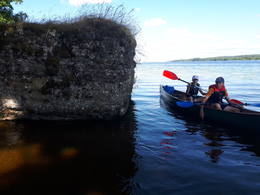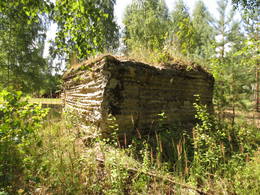Prisiminimai iš dienoraščio, palikto tarnaujant Kegumo HE
Jānis Jaunozoliņš. „Prisiminimai iš dienoraščio, palikto svetur“ (1944 08 16-1946 10 13.) Fragmentai.
Stotyje jau laukia keleivinis traukinys, kuriuo prasideda kelionė į seniai girdėtą, bet dar nematytą Kegumą. Visi puikiai nusiteikę. Jaučiamės kaip tikri kareiviai, nors mūsų palydovai ir vadai tėra vokiečiai, kuriuos tyliai vadiname „fricais“.
Dieną ir naktį viena mūsų grupė turėjo budėti prie kiekvieno stelhungo, t. y. keturvamzdžio priešlėktuvinio pabūklo, prožektoriaus ar oro baliono, išdėstyto aplink Kegumo elektrinę. Vienas iš keturvamzdžių pabūklų yra pastatytas ant elektrinės stogo. Mūsų grupė taip pat pirmą kartą turi išeiti prie baliono ir prožektoriaus. Ryte visi turi eiti prie išėjimo, kur paskiriamas sargybos pasikeitimas. Gauname ginklus, amuniciją ir, vadovaujami puskarininkio, per Kegumo tiltą einame į vieną iš tolimesnių stelhungų (slėptuvių). Prie kiekvieno baliono ir prožektoriaus esame suskirstomi į dvi dalis, tada mums išsamiai paaiškinami saugomi objektai, užduotys ir taisyklės, nors teoriškai ir praktiškai to jau buvome išmokę mokymų metu. Tačiau senoji pamaina vyksta į stovyklą. Diena rami, o balionai laukia. Reikėtų paaiškinti, kad balionai buvo pakelti į orą aplink Kegumo elektrinę ir tiltą, kad žemai skraidantys priešo lėktuvai negalėtų tiesiogiai pataikyti į taikinį.
Kur beeitume, net į virtuvę pietauti, turime žygiuoti pagal dainą. Jei po komandos dainos negalima pradėti, tada duodamas įsakymas „atsigulk, kelkis, bėk“, taigi turime pasirinktą dainos pradžią.
Dažnai esame siunčiami dirbti prie naujų įtvirtinimų statybos. Aplink Kegumą yra išsidėsčiusios dvi priešlėktuvinės baterijos su maždaug 48 balionais, priešlėktuviniais pabūklais ir prožektoriais.
Per visą laiką, praleistą Kegumuose, nė vienas priešo lėktuvas neįskrido į balionų pakeltus skersinius, nes balionai neleido jiems skristi žemai. Kegumo tiltas liko nepažeistas, nors buvo daug kartų atakuotas.
Andersone, R. 2004. Kegumo hidroelektrinė. 74 psl.
Susijusi laiko juosta
Susijusios vietos
Vokiečių armijos betoninis ugnies punktas prie Kegumo HE rezervuaro Žegos upės žiotyse
Įsikūręs Kegumo HE rezervuare prie Žegumo upės žiočių (priešais Žegumo namus), kairiajame jos krante. Vienas vizualiai ir vaizdingai įspūdingiausių bei geriausiai išsilaikiusių betoninių gaisrinių, skalaujamų Dauguvos bangų. Jį galima pamatyti iš didesnio atstumo. Nuo kranto iki gaisrinės viršūnės (apaugusios žole) pastatytas pėsčiųjų tiltas. Į gaisrinės betonines sienas įmūryti siaurojo geležinkelio (?) bėgiai. Į jį galima patekti nuo pėsčiųjų tilto. Tai vienas iš Vokietijos armijos Pirmojo pasaulinio karo gynybos linijos ugnies taškų kairiajame Dauguvos krante, kurį galima daugiau ar mažiau atsekti per visą Dauguvos kairįjį krantą. Minėta gynybos linija yra didelio masto karinė sistema, kuri dar nėra iki galo įvertinta kaip vientisas darinys. Gaisrinės liekanas galima apžiūrėti plaukiant valtimi Kegumo HE.
Vokiečių armijos betoninis ugnies punktas viršutiniame Kegumo HE krante priešais Andulį
Jis yra apie 1,2 km į rytus nuo nedidelio upelio, išplatėjusio (upelis įteka į Lejasgrantinius) stataus Kegumo HE kranto šlaito viršuje priešais Andulius. Šioje vietoje krantas apaugęs mišku ir pomiškiu, todėl tik atidus stebėtojas pastebės šį gaisro tašką iš rezervuaro pusės. Gaisro taškas yra gerai išsilaikęs, nes jo nepažeidė kranto erozija. Tai vienas iš Vokietijos armijos Pirmojo pasaulinio karo gynybos linijos ugnies taškų Dauguvos upės kairiajame krante, kurį galima daugiau ar mažiau atsekti per visą Dauguvos upės kairįjį krantą. Minėta gynybos linija yra didelio masto karinė sistema, kuri dar nėra tinkamai įvertinta kaip vientisas darinys. Gaisro tašką galima apžiūrėti plaukiant valtimi Kegumo HE, nes jis yra privačioje teritorijoje.
Vokiečių armijos betoninio ugnies punkto liekanos Kegumo HE rezervuare priešais Sidrabinius
Įsikūręs apie 0,25 km į rytus nuo Kegumo HE rezervuaro įlankos netoli Silapūpēžių, Jaunjelgavos kryptimi, priešais Sidrabinių ūkį. Gaisrinė iš dalies įgrimusi į vandenį ir suskilusi į kelias dalis, primena statybinių atliekų krūvą. Krantas apaugęs. Tai vienas iš Vokietijos armijos Pirmojo pasaulinio karo gynybos linijos ugnies taškų kairiajame Dauguvos krante, kurį galima daugiau ar mažiau atsekti per visą Dauguvos kairiojo kranto ilgį. Minėta gynybinė linija yra didelio masto karinė sistema, kuri dar nėra iki galo įvertinta kaip vientisas darinys. Gaisrinės liekanas galima apžiūrėti plaukiant valtimi palei Kegumo HE. Apie 150 m į vakarus nuo Dauguvos kranto į vandenį įgriuvo dar vieno gaisrinės liekanos.







